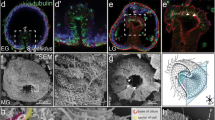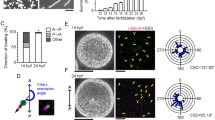Abstract
Electron microscopy of Macrostomum hystricinum raised in culture shows that ciliogenesis in the worm's epidermal blastomeres begins in embryos 39–41 h old with kinetosomal and de novo genesis of presumptive basal bodies, which are morphologically distinguishable from centrioles of the mitotic apparatus, and proceeds by the migration of basal bodies to the apical plasma membrane of the cells and their production there of ciliary axonemes by an age of 51–53 h when the bastomeres emerge between yolk cells on the embryo's surface. Ciliogenesis continues throughout development with the addition of cilia virtually one by one to the expanding epidermal cells' surfaces. At no time in ciliogenesis are stages seen that might show derivation of these multiciliated cells from the primitive monociliated cell type presumably present in the ancestors of the Turbellaria.
Similar content being viewed by others
References
Allen, R. D., 1969. The morphogenesis of basal bodies and accessory structures of the cortex of the ciliated protozoan Tetrahymena pyriformis. J. Cell Biol. 40: 716–733.
Anderson, G. W., 1972. The three-dimensional structure of the basal body from the rhesus monkey oviduct. J. Cell Biol. 54: 246–265.
Anderson, R. G. W. & Brenner, R. M., 1971. The formation of basal bodies (centrioles) in the rhesus monkey oviduct. J. Cell Biol. 50: 10–34.
Apelt, G., 1969. Fortpflanzungsbiologie, Entwicklungszyklen und vergleichende Fruhentwicklung acoeler Turbellarien. Mar. Biol. 4: 267–325.
Ash, B. M. & Stephens, R. E., 1975. Ciliogenesis during the sequential formation of molluscan gill filaments. Dev. Biol. 43: 340–347.
Ax, P., 1963. Relationships and phylogeny of the Turbellaria. In Dougherty, E. C. (Ed.), The Lower Metazoa. Univ. California Press, Berkeley. pp. 191–224.
Bedini, C. & Papi, F., 1974. Fine structure of the turbellarian epidermis. In Riser, N. W. & Morse, M. P. (Eds.), Biology of the Turbellaria. New York: McGraw-Hill, pp. 108–147.
Bresslau, E., 1904. Beitrag zur entwicklungsgeschichte der turbellarien. I. Die Entwicklung der Rhabdocölen und Alloiocölen. Z. wiss. Zool. 76: 213–332.
Chang, P., et al., 1979. An ultrastructural study of morphogenesis of fibrogranular complex and centriole in ductuli efferentes of chinese hamster. Tiss. Cell 11: 401–412.
Dippell, R. V. 1968. The development of basal bodies in paramecium. Proc. Nat. Acad. Sci., USA 61: 461–468.
Dirksen, E. R. 1971. Centriole morphogenesis in developing ciliated epithelium of the mouse oviduct. J. Cell Biol. 51: 286–302.
Dirksen, E. R., 1974. Ciliogenesis in the mouse oviduct. A scanning electron microscope study. J. Cell Biol. 62: 899–904.
Ehlers, U., 1977. Vergleichende untersuchungen uber collarrezeptoren bei turbellarien. Acta Zool. fenn. 154: 137–148.
Grimes, G. W., 1973. Origin and development of kinetosomes in Oxytricha fallax. J. Cell Sci. 13: 43–53.
Guillard, R. R. L. & Ryther, J. H., 1962. Studies on marine planktonic diatoms. I. Cyclotella nana Hustedt and Detonula confervacea (Cleve) Gran. Can. J. Microbiol. 8: 229–239.
Kalnins, V., 1967. Ultrastructural observations on the development of cilia in the trochophore of Nereis limbata. Biol. Bull. 133: 472–473.
Kalnins, V. I., Chung, C. K. & Turnbull, C., 1972. Procentrioles in ciliating and ciliated cells of chick trachea. Z. Zellforsch. 135: 461–471.
Kalnins, V. I. & Porter, K. R., 1969. Centriole replication during ciliogenesis in the chick tracheal epithelium. Z. Zellforsch. 100: 1–30.
Karling, T. G., 1974. On the anatomy and affinities of the turbellarian orders. In: Eds. Riser, N. W. & Morse, P. W. New York: McGraw-Hill. pp. 1–16.
Ludwig, H. & Metzger, H., 1977. Ciliogenesis in human fetal oviduct. Scanning Electron Microscopy, 1977(II): 361–366.
Lyons, K. M., 1973a. Evolutionary implications of collar cell ectoderm in a coral planula. Nature 245: 50–51.
Lyons, K. M., 1973b. Epidermal fine structure and development in the oncomiracidium larva of Entobdella soleae (Monogenea). Parasitology 66: 321–333.
Lyons, K. M., 1973c. Collar cells in planula and adult tentacle ectoderm of the solitary coral Balanophyllia regia (Anthozoa Eupsammiidae). Z. Zellforsch., 145: 57–74.
Nørrevang, A., 1964. Choanocytes in the skin of an enterpneust. Nature (London) 204: 398–399.
Nørrevang, A. & Wingstrand, K. G., 1970. On the occurrence and structure of choanocyte-like cells in some echinoderms. Acta Zool. (Stockh.) 51: 249–270.
Pitelka, D. R., 1974. Basal bodies and root structures. In: Ed. Sleigh, M. A. Cilia and Flagella. New York: Academic Press, pp. 437–469.
Rieger, R. M., 1976. Monociliated epidermal cells in Gastrotricha: significance for concepts of early metazoan evolution. Z. zool. Syst. Evolutionsf. 14: 198–226.
Rieger, R. & Tyler, S., 1979. The homology theorem in ultrastructural research. Am. Zool 19: 655–665.
Ruffolo, J. J., Jr., 1976. Cortical morphogenesis during the cell division cycle in Euplotes: An integrated study using light optical, scanning electron and transmission electron microscopy. J. Morph. 148: 489–528.
Salvini-Plawen, L. v., 1978. On the origin and evolution of the lower Metazoa. Z. zool. Evolutionsf. 16: 40–88.
Seilern-Aspang, F., 1958. Die Entwicklung von Macrostomum appendiculatum (Fabricius). Zool. Jb. Anat. 76: 311–330.
Soltynska, M. S., Mroczka, B. & Moraczewski, J., 1976. Ultrastructure of epidermis in Turbellaria from the family Catenulida (Archoophora). J. Submicr. Cytol. 8: 293–301.
Sorokin, S. P., 1968. Reconstructions of centriole formation and ciliogenesis in mammalian lungs. 1968. J. Cell Sci. 3: 207–230.
Steinman, R. M., 1968. An electron microscopic study of ciliogenesis in developing epidermis and trachea in the embryo of Xenopus laevis. Am. J. Anat. 122: 19–56.
Tyler, S., 1979. Distinctive features of cilia in metazoans and their significance for systematics. Tiss. & Cell. 11: 385–400.
Tyler, S., (in prep.) Ciliogenesis in embryos of the acoel turbellarian Archaphanostoma.
Yousen, J. H., 1979. Centriole duplication and ciliogenesis in differentiation of the lamprey tubular nephron. Anat. Rec. 193: 729.
Author information
Authors and Affiliations
Rights and permissions
About this article
Cite this article
Tyler, S. Development of cilia in embryos of the turbellarian Macrostomum. Hydrobiologia 84, 231–239 (1981). https://doi.org/10.1007/BF00026184
Issue Date:
DOI: https://doi.org/10.1007/BF00026184




